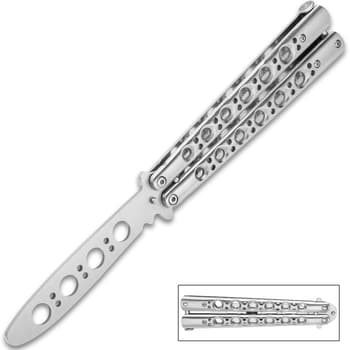Becoming a Butterfly Knife Master

By Desiree Weeks
Butterfly knives, also known as balisongs or fan knives, are some of the most easily identifiable knives on the market. Their distinct appearance set it apart with the blade being held between its two handles when closed. It’s also these dual handles that allow for all kinds of unique tricks.
There are two different types of construction when it comes to these knives: “sandwich construction” and “channel construction.” The sandwich construction knives are traditionally assembled in layers and held together by pins or screws. Channel construction means the main part of each handle is formed from one piece of material.
While the choice of construction is up to you, they all operate in the same way. It’s the flipping of the butterfly knife that many owners have come to love but it’s also an art that can take a bit of practice. It’s important to note that butterfly knives are still sharp weapons and you may want to opt for a trainer when first starting out. BudK offers a variety of these including the Black Legion Balisong Trainer Knife. Trainers forego the sharp-edged blade, allowing you to practice flipping and tricks without fear of injury. It's also important to note that the “bite handle” of the butterfly knife is the one on the side of the sharpened edge while the “safe handle” is the one that keeps you protected from the blade’s edge.
Now, onto the fun stuff: how to do a few tricks.
Flick Opening and Flick Closing
Every master must have a strong foundation and all butterfly knife tricks stem from knowing how to properly open and close the knife. To perform a flick opening, the wrist must flick the bite handle away, allowing the blade to come out and away from it. Then you must spin the safe handle which will make the bite handle and blade meet the back of your hand. Flicking your wrist back will allow the handle to close together in your hand, bringing the knife to the open position.
Flick closing is simply reversing the above process by flicking the bite handle into your open palm, ending up with both handles securely closed around the blade in your palm.
Pinwheel
Like its name suggests, this trick involves the continuous spinning of the knife, although it may take quite a bit of practice to become seamless at it. The basics of a pinwheel involve holding the knife horizontal with the tang pins aligned with your thumb. You then hold the safe handle and drop the bite handle, flipping it around while shifting your grip. This will bring the bite handle upward and snapped into its closed position. This trick is a favorite but can also be a tricky one to master and it’s recommended that beginners start out using either a trainer or tape over the sharp edge of the blade.
Aerial
An aerial is a difficult trick that can be tough to learn but super cool when mastered. It can also be incorporated into many other complicated tricks. Just as it would sound, an aerial involves flipping the butterfly knife into the air and catching it again. You’ll want to start by holding the bite handle so you’ll catch it with the blade with the cutting side down. Release the safe handle and flip the knife into the air, allowing it to do one rotation, and catch it by the bite handle.
While it may sound simple, this is a trick that will require a lot of practice to get your timing just right. It’s also important to remember that for this trick, if using a live blade, it’s better to catch the knife later rather than earlier to reduce chances of being cut by the blade.
Y2K Rollover
Another trick that will take some practice is the Y2K rollover. To start out, hold the knife closed vertically by the bite handle as you would hold a pencil between your thumb and index finger. You then throw your safe handle down and just as the safe handle hits your thumb, you’ll release your index finger from the bite handle and catch the safe handle as the knife rolls around your thumb. This trick requires a lot of practice as you briefly lose your grip entirely on the knife, but it looks super cool when performed properly.
Feeling Inspired?
If you’re wanting to give some of these tricks a try or if you’ve been wanting to add to your existing butterfly knife collection, take a look at all the butterfly knives we have to offer.
Related Products























